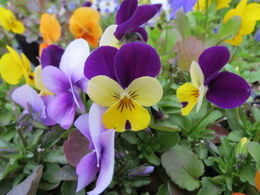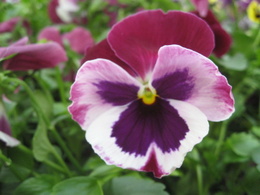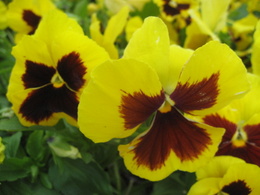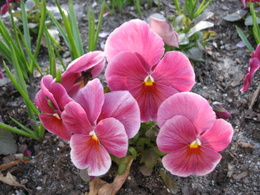Pansy and Viola Growing Guide
Pansy (Viola x wittrockiana) are viola hybrids. They are cool weather perennials and will do well in USDA Zones 4 to 8. Pansy and viola plants look their best during the cool spring season, but their flowering drops off with the heat of the summer months and are usually grown as annuals. They come in a variety of colors and come in 3-basic color patterns. The first pattern is of a single color. The second is a single color with lines radiating from the center. The third and most common have a dark center pattern which gives the pansy a face-like look.
Pansy plants are in the Viola genus, which has more than 500 varieties and is native to Europe. Due to hybridizing, pansy and violas have a very similar appearance. Many of the viola varieties sold in garden centers are labeled as pansy plants. The Horticultural Trades Association considers the names ‘pansy’ and ‘viola’ as interchangeable.
Bloom colors usually include purple, blue, pink, white and yellow.
It takes a bit of a sharp eye to tell the difference between a pansy and a viola. The pansy flower has 4-petals pointing upwards and 1-petal pointing downward. The viola flower has 3-petals pointing upwards and 2-petals pointing downward.
Their growth habit is low and should be planted in front of taller flowers. Pansies and violas prefer cool weather and can take a light frost. You will find them in the garden centers in the early spring and fall. They often do not do well in very hot weather and are usually replaced with a heat-loving annual.
Starting Pansy and Viola From Seed
Follow the directions on the seed package. Pansy and viola plants can be started indoors 10 to 12-weeks before your last expected frost date. For more guidance our seed starting page will be helpful.
Soil Preparation
Plant pansies or violas in full sun to part sun in a nice loose well-drained garden soil and will do best in a slightly acid soil with a pH range of 6.0 to 6.5.
When to Plant
They should be planted in the late spring after the last expected frost. They can take a light frost and it is common to plant them a couple of weeks earlier when the soil temperatures are between 45-degrees F and 65-degrees F. If a hard frost is expected give them some protection by covering them.
Planting Pansy
Plant them 6 to 12-inches apart in front of taller plants. Dig a hole as deep as the pot and twice as wide. To the soil you just removed add the same amount of good garden soil so you have a nice blend of new and native soil.
Take the plants out of the pot and gently loosen the root ball pulling away any roots that have grown in a circle around the pot.
Place the root ball in the hole with the growing crown of the plant even with or an inch higher than the surrounding soil. Gently spread out the roots and back fill the hole around the root ball leaving a shallow depression around your plant. Fill the depression with water to settle the soil around the roots adding more soil if necessary and water again. Water daily tapering off as the pansy and viola roots grow and get established.
Watering and Care
Pansies and violas are low maintenance and easy to care for. All you need to do is add a layer of mulch to help retain moisture and keep out competing weeds. Your pansies and violas should get an inch of water each week and during dry spells give some water to keep the soil moist. They usually do not need any fertilizer, but a light side dressing of an organic fertilizer such as Espoma Flower-tone can be placed around the plant in the spring.
Diseases and Pests
Pansies and violas have few problems. As the weather warms up slugs, aphids, mealybugs and spider mites may occur.
Slugs can be controlled with a product such as Bonide Slug Magic containing iron phosphate, which is certified organic and can be used up to the day of harvest.
Aphids, mealybugs and spider mites can be controlled with an organic product such as Bonide insecticidal soap.
In wet weather powdery mildew and downy mildew are things to be on the lookout for. For serious problems an organic product such as Bonide neem oil can be used
Popular Varieties
Popular varieties: Aspasia, ‘Bingo’ Series, Black Moon, ‘Crystal’ Series, ‘Delta’ Series, ‘Happy Face’ Series, Imperial, Jackanapes, Johnny-Jump-Up, ‘Joker’ Series, Moonlight, ‘Princess’ Series, Ultima Silhouette, ‘Universal Plus’ Series.
Sources: Burpee, Eden Brothers, Park Seed Co.
Garden Spikes newsletters give you timely information once or twice a month. Subscribe Free to the Garden Times newsletter below.
Your email address will only be used to send you a newsletter and will never be sold. You can unsubscribe at any time.




